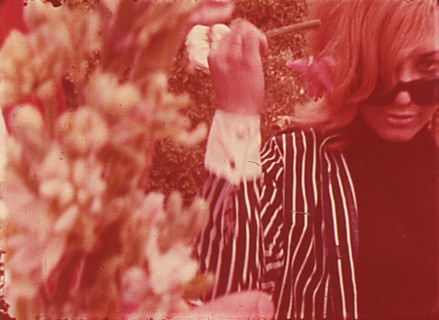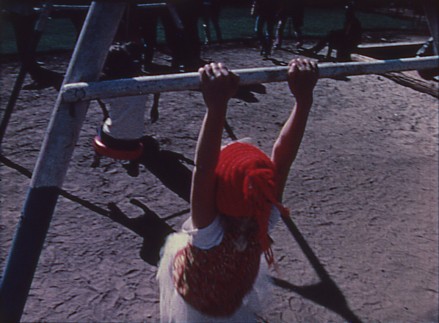
The Elysian Park Love-In and the Destruction of the People's Park
Films
- Read More
 Documentary
DocumentaryGod Respects Us When We Work But He Loves Us When We Dance
Les Blank16mm, color, sound, 20 minRental format: 16mm - Read More
 Experimental
ExperimentalVagabond
Bob Mulqueen16mm, color, sound, 5.75 minRental format: 16mm - Read More
 Experimental
ExperimentalLet A Thousand Parks Bloom
Lenny Lipton16mm, color, sound, 27 minRental format: 16mm
Description
For the third screening in our multi-program series FILMS FOR SOCIAL CHANGE: REVISITED AND EXPANDED, join us at the FMC Screening Room on March 11th, 2024, at 7pm, for four films chronicling the Elysian Park Love-In, the People's Park, and related protests and demonstrations in the late 1960s.
A Tale of Two Parks
The out and out escapist utopianism of the first ‘Love-In’ of 1967 (a banner year for hippiedom that ushered in the first ‘Summer of Love’) saw some 15,000 attendees to Elysian Park in Los Angles on Easter Sunday embrace in a sensory and hedonistic revelry seemingly miles away from the uprisings, rebellions, and turmoil that had marked the city in previous years (LA, in the wake of the Watts uprising, became a synonymous with the much-touted phrase ‘urban crisis’). Flanked by performances by some well-known (Strawberry Alarm Clock) to now largely-forgotten psychedelic rock outfits (The Peanut Butter Conspiracy, presumably playing cuts from their soon-to-released debut album The Peanut Butter Conspiracy is Spreading), complete with facepainting and lubricated with choice substances, the event was amongst the most innocent and archetypical of early marquee events for the counterculture. The LA-based Love-In is less well chronicled than the Timothy Leary- and Allen Ginsberg-led ‘Human Be-In’ in San Francisco that took place in January of the same year and was decidedly less explicitly political in its advocacy for the emancipatory potential of psychoactive substances. Antiwar sentiment is also curiously muted at the Los Angles festivities, with a prominent appearance from the satirical character General Hershey Bar (actor and dancer Bill Matons, in excessive military garb offering a parody of the then head of the Selective Service System U.S. General Lewis B. Hershey) but no rallies or speeches. The more hedonistic, free-form nature of the event is captured as a panoply of wonderstruck idealism in Les Blank’s early film God Respects Us When We Work But He Loves Us When We Dance. The film offers a patchwork overview of the festivities rendered with deep hues of saturated color which underline the polychromatic explosion of the hippie aesthetic against the staid fashions and visual culture of the first half of the decade. Accompanying Blank’s idyll here is a virtually unseen film Vagabond by West coast filmmakers Bob Mulqueen and John Simons (often working together under the moniker ‘Cultural Expansion’). Their short document overlays a titular poem, composed for the film, that further underscores the innocence of the communitarian endeavor and gestures also to the naiveté of this seemingly isolated Valhalla.
The conception of community-driven public space as a slice of heaven on earth was realized for a fleeting period in the Spring of 1969 by a group of residents, students, professors, and activists who transformed a disused and vacant piece of land some 350 miles to the North of Los Angeles in the beating heartland of the counterculture: Berkeley. The plot had sat empty after being razed a year before by the University of California who still owned the property. The group began to appropriate the space, utilizing it as a community garden, a location for ecological pedagogy, and public space built on sweat equity. In the words of architectural historian Sabrina Gabrielle Richard, the park "quickly became a space for the reimaging of property ownership, urban land use and the relationship between the human and non-human world" and is seen by historians of the New Left as an early pivot toward ecological and environmental concerns for the movement.
Due to events transpiring shortly after its opening, the space would also become a central site of contention, symbolic of the wider, and soon to be common, violent suppression of dissent and rebellion in the United States. The University, along with the office of the Governor of California saw the use of the park as an illegal occupation. An architecture possessor at Berkeley, Sim Van der Ryn, who focused on the integration of architectural design with social justice and later self-sufficient ‘eco buildings’ was a key proponent of the park and advocated on its behalf in negotiations with the University and Governor Ronald Reagan’s deputies. Clashes between local police and the park’s users and creators quickly escalated after the University’s Regents erected a fence around the park. Students, following a demo, vowed to take it back. The National guard was enlisted to clear the park on May 15. State and federal troops soon occupied the city and a student, James Rector, was fatally wounded by a shotgun blast to the back; the painter Allen Blanchard was left blinded in the pandemonium and scores more were injured. Three years before the fatal shootings of four students striking against war in Vietnam at Ohio’s Kent State University, ‘Bloody Thursday’, as the day became known, represented one the few instances of unarmed civilians being killed for dissent in the U.S. (the other, less well-remembered instance, also from 1968, was the killing of three Black students attempting to desegregate a bowling alley at South Carolina State College in Orangeburg). It is the only instance in history of people being shot for attempting to bolster and improve the urban environment.
Lenny Lipton, the filmmaker, poet, and pioneer of three-dimensional image projection, was resident in Berkeley at the time and contributor to the noted underground newspaper The Berkeley Barb. His filmic record of the park and its fate, Let A Thousand Parks Bloom, is the best known of his early 16mm films and the most holistic record of the park during this time on film. The film is broadly split into two competing sections, the first is aligned with the vision of Elysian Park espoused in the first two films: it is bucolic and utopian. Containing footage of other parks, Provo Park (Berkeley, CA) and Speedway Meadows (San Francisco, CA) that are complete and being enjoyed by the public, the first section acts as a counterpoint to the second part of the film that captures the action and labor necessary to bring the People’s Park to fruition; it also depicts the park’s constant surveillance by authorities; and the symbolic protests of the park users’ ritualistic burning and ceremonially burying a pig. The stark juxtaposition of children at play amongst see-saws and jungle gyms and the pleasure taken by groups of people in making the park against the reality of the park’s destruction and the heavy-handed removal of its public is striking—it is a eulogy cast as a blunt and affecting dialectic. Other than various shots of the police and troops circling the city there is a lack of direct clashes depicted in the film, the murder of Rector is present almost subliminally with a haunting whisper of his name overlaid on the soundtrack part way through.
Less lush and certainly impossible to label utopian, Newsreel’s film People’s Park is in keeping with their raw aesthetic. Opening after the fact, the film recounts through a central on-screen narrator, the events around the park’s formation and the quashing of the student rebellion against the University on Bloody Thursday. The presence of a cohering interlocuter gives the film a grounding that is lacking in other early Newsreel efforts but the visceral battle footage, with filmmakers in and amongst the tear gas and lobed missiles, lends the film a violent realism. It is during these cataclysmic action sequences that the film’s soundtrack settles into the denser, layered non-synch sound expected from a Newsreel production. Beyond this the film also contains more uninterrupted and legible perspectives from observers, one of whom is completely in favor of the use of deadly force. The use of montage is also here more pronounced with a satirical presentation of the Regents of university (represented by their official portraits and interspliced with cartoon dollar bills and mugshots of Mickey Mouse). The film closes with a sober institutional critique of the role of University as a corporate actor in the state of California ensconced with the agribusiness industry and various environmentally detrimental institutions. This diatribe is quickly expanded to advocate for coalition building and intersectionality across the frontlines of unionism and racial equity, seeing the issue of the People’s Park in Berkeley as a sweeping microcosm of the problems in America more broadly.
As Bloody Thursday ended, Governor Reagan established martial law in Berkeley. Beginning on May 16, three National Guard battalions, with supporting units under the tactical direction of Alameda County Sheriff Frank Madigan, occupied the city, erecting barricades and clearing the streets. Although he limited their mission on May 25, Governor Reagan did not recall the troops until June 2. The park operates to this day as a semi-public space though its formal ownership is still contested. A mural depicting the events of the day (and other aspects of the park’s history) designed by Osha Neumann was unveiled in 1976 along Telegraph Avenue, acting as a permanent monument to the park’s radical history.
***
*This program also includes People’s Park by Newsreel (black and white, sound, 23 minutes).*